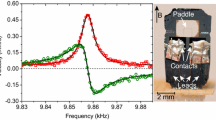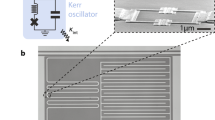Abstract
Quantum oscillatory effects provide particularly unambiguous information about the properties of quasiparticles in metals, and have consequently been used for the purpose of understanding the low temperature behaviour of a wide variety of metallic elements and compounds, including the recently discovered heavy fermion materials. Unfortunately, the signals which are produced by these oscillations are often so weak as to be undetectable, because of the high effective masses of the quasiparticles, or the presence of imperfections in the samples, or otherwise. In order to improve our ability to measure these effects, the author has developed a system for the detection of resistance oscillations which uses a SQUID as the amplifying element and which fits inside a toploading dilution refrigerator probe. It has proven possible to use this instrument to investigate very elusive phenomena in samples which have been cooled to 0.02 K in magnetic fields of 13.7 tesla. For example, although no resistance oscillations have previously been seen in aluminum, except under conditions of magnetic breakdown, the new system has made it possible to detect resistance oscillations in this material under relatively arbitrary conditions. In the case of the heavy fermion compound CeRu2Si2, oscillations of 10−9 Ω have been detected against a background resistance of about 10−5 Ω, using excitation currents of around 10−2 A.
Similar content being viewed by others
References
G. G. Lonzarich,J. Magn. Magn. Mat. 76 & 77, 1 (1988).
M. I. Grossbard,J. Phys. F. 9, 1833 (1979).
C. O. Larson and W. L. Gordon,Phys. Rev. 156, 703 (1967).
B. K. Howard, Ph.D. Thesis, University of Cambridge (1989).
P. Haen, J. Flouquet, F. Lapierre, P. Lejay, and G. Remenyi,J. Low. Temp. Phys. 67, 391 (1987).
H. R. Ott, H. Rudigier, Z. Fisk, and J. L. Smith,Physica 127B, 359 (1984).
Z. Fisk, P. C. Canfield, W. P. Beyermann, J. D. Thompson, M. F. Hundley, H. R. Ott, E. Felder, M. B. Maple, M. A. Lopez de la Torre, P. Visani, and C. L. Seaman,Phys. Rev. Lett. 67, 3310 (1991).
Author information
Authors and Affiliations
Rights and permissions
About this article
Cite this article
Walker, I.R. The observation of resistance oscillations in metals at high magnetic fields using a SQUID. J Low Temp Phys 90, 205–241 (1993). https://doi.org/10.1007/BF00682000
Received:
Issue Date:
DOI: https://doi.org/10.1007/BF00682000




